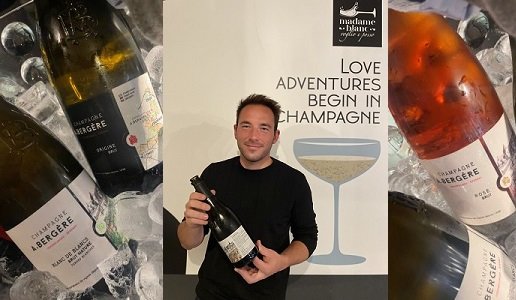Young Champagne producer Adrien Bergère, the third generation (all named in A) to make wine in Champagne, has clear, scientific ideas about how to produce, with just a little homage to tradition.
I met a young Champagne producer.
32 years old, 70 hectares of vineyards in Champagne, al battle cry: Rien de grand ne se fai sans Passion. Between Chardonnay, Pinot Noir and Meunier, the vineyards are mainly located in Vallée du Petit Morin and Côte Des Blancs. For three generations the Bergère family has been producing grapes, which they confer and partly vinify under their own labels. It all began in the 1800s but it was in 1949 that grandfather Albert founded the Maison as we understand it today, he was succeeded by André to arrive at today with Adrien. All with an “A”.

How the taste and way of making Champagne is changing, I tried to ask Adrien; his answers (somewhat restrained by his being so French) are partly what I expected, with some intriguing, and enlightening, notions about his view of wine and how to turn it into Champagne. One would expect a young producer to make wine for young people. One would think so in every territory to be honest, and instead how often do we hear of young winemakers and/or producers making wine the way grandpa made it? Nothing wrong with respecting “tradition” as long as we do not fall into what I think is the mistake of neglecting the changing times but also the new generations of consumers who (as well as producers) alternate over time, as is only natural. Talking with Adrien, language barriers aside, I instead glimpsed a glimmer of hope in this regard. His ideas on how to make wine are clear and scientific, with just the right dash of tradition. Today the Maison produces about 30,000 bottles divided among 12 labels. Adrien’s style is first and foremost respectful of the terroir, and in the cellar his contribution translates into three basic pillars.
The first I could sum up in the concept of taste, accomplices being the use of wood, reserve wines and the reduction of dosage.
The second I traced back to the feel and concerns the resting on the lees before frothing.
The third evoked the concept of time to me, in terms of parceling and corked frothing.
Taste: Bergère’s base wines almost always rest at least partially in wood. The preferred format is the 228-liter piece. The use of concrete and stainless steel are also not disdained, and contribute to the style. One only has to look at the (very detailed) labels to realize that dosages are lower and lower; Origine, which marks Adrien’s debut as official winemaker, has 4 to 5 g/l of sugar. Partially vinified in 228-liter barrels and blended with 30% reserve wines, consisting of 70% Chardonnay, 20% Pinot Noir and 10% Meunier it is unbeatable for drinkability and ease. If it didn’t cost 58€ I could tell you that it is an everyday product. Also representative of this young producer’s vision is the Solera. Cuvée composed of 50% from the last vintage and 50% from reserve wines. Partially vinified in 228-liter barrels, 100% Chardonnay. Direct offspring of another very significant wine, the Blanc de Blancs Terres Blanches, unmetered and partially fermented in wood.

Tact: Interesting and intriguing view Adrien’s takes on the management of base wines for which he reserves a longer stay in tank or barrel than stays on the lees in the bottle. The contribution that a more cellar-aged base can make is in his view significantly more interesting than a Champagne with many months sur lie. It really does seem that these Champagnes seek a softness, also aided by the unfolding of malolactic fermentation, and a complexity more of wine than of bubbles.
Time: Let us end with the concept of time that well covers A. Bergère’s single plot Champagnes. Adrien identifies particularly interesting plots for the Maison and decides to vinify them separately, producing limited editions. He also reserves a special condition for them in the course of frothing, which does not take place with a crown cork but with a cork and staple. According to his experience, not only does this change the taste, going to enhance the peculiarities of the individual plots giving more character and personality, but it also guarantees longer and safer stays on the lees in the bottle. In fact, after the first few years, Adrien explains to me, you can feel the difference by becoming more cork tight than a plastic bidule.
I don’t begrudge the true Champagnista experts for trying to summarize complex and by no means trivial concepts such as these in three items. Rather, I hope they can be, as they have been for me, excellent food for thought about where a true myth like Champagne is going and how it will continue to exist. Tastings of the two Champagnes that I enjoyed most for drinkability, style and memorability follow. Click on the name to open the card with description, price and score.





